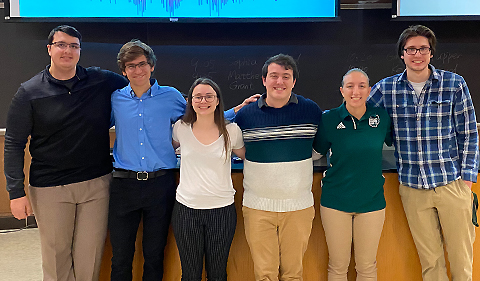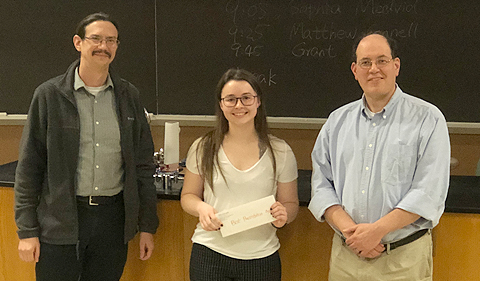Six Ohio University undergraduate Physics & Astronomy students presented an overview of their projects undertaken the previous summer, during the 2019 Society of Physics Students (SPS) Research Conference held recently in Clippinger Labs.
First place winner Miranda Carver, a senior physics major in the College of Arts and Sciences, presented a 15-minute talk, “An Analysis of ???? ????→????????0????0 Reaction at CLAS.” Carver did summer research in particle physics at Italy’s National Institute of Nuclear Physics in Genova, under the direction of Andrea Celentano, and at OHIO with Dr. Kenneth Hicks, a professor in the department. The National Science Foundation and the department sponsored her travel to Italy.
Carver is interested in a subatomic particle called a meson, which is intermediate in mass between an electron and a proton and transmits the strong interaction that binds nucleons together in the atomic nucleus. Specifically, she studies a meson called the f2(1270) which is of interest because it is part of a spectrum of mesons, each having a unique mass. One of the goals of particle physics is to predict the spectrum of mesons from the fundamental theory of the strong force, called Quantum Chromodynamics, or QCD.
“I am studying the very small parts of what makes up the universe,” Carver said. “What makes this very difficult is these particles have a short lifetime therefore we need excellent particle detectors in order to observe them and how they interact. The particle detector I used for this experiment is called CLAS, and it is a large acceptance spectrometer, meaning that it can detect particles over a large range of emitted angles. The CLAS detector is located at Jefferson National Laboratory, in Newport News, Virginia.”
SPS Faculty Adviser Dr. Gang Chen facilitated the morning’s program and judging. Judges for the event were Dr. David Tees and Dr. Paul King.
When asked what they look for in an excellent presentation, Tees said the judges want the presenters to take into account the diversity of the audience, to explain background concepts, and provide context that is understandable and appreciated by an audience of physicists. That along with excellent graphics and presentation style helps a presentation to stand out.
“While all of the presenters did a great job of presenting their work, Miranda’s presentation style was excellent in explaining her results,” Tees said. “She did an outstanding job of setting her work in its context with background. She also responded to questioning with the authority of her experience.”
When asked about the value of students participating in the SPS conference, Tees said, “Their presentations help to demystify the process of doing undergraduate research and demonstrate the successes and challenges that are always present in any research project. They gain experience in presenting to a professional audience that’s a bit more general than their own research group or to the field specialists that they might have encountered at external research conferences.”

2019 SPS conference undergraduate presenters are (L to R) Kevin Ward, Matthew Connell, Miranda Carver, Graham Tupper, Sophia Medvid, Grant Merz.
Honorable Mention Awarded to Matthew Connell and Sophia Medvid
Two other students impressed the judges and shared the Honorable Mention award. Matthew Connell, a senior physics major in the Honors Tutorial College, presented, ‘The Kinematics of diHiggs Decay Products in the bbVV Final State’, a project he worked on in Germany at the Georg-August-Universitat Gottingen. DAAD, the German Academic Exchange Service, as well as the German RISE program sponsored Connell’s summer internship.
“My work in Gottingen was in studying the properties of particles that come out of a particular reaction in a particle collider, Connell said. “I worked with simulated data, called “Truth Containers,” which held simulated particle collisions. The particular reaction I looked at is one where two Higgs bosons are produced simultaneously, (or “diHiggs”,) and then those Higgs bosons eventually decay into their final state, a set of particles notated as bbVV. I studied the direction of motion, momentum, and energies that the particles would have throughout this experiment, through the simulations. I plotted these kinematic distributions in histograms to make the physics that is happening on this level more visible.”
Sophia Medvid, a senior engineering physics major in the Honors Tutorial College, spent her summer on the Athens campus where she studied under the direction of Dr. Martin Kordesch, a professor in the Department. Her presentation, ‘Analysis of Vibrational Modes of a Mellophone’ described her study of vibrations of the bell of a mellophone to see if it significantly affects the sound of the instrument.
“I am studying the normal modes of brass plates and the mellophone bell using Chladni Patterns and piezoelectric sensors and mapping the contours and behaviors of their vibrations,” Medvid said. “I am a musician and want to know if the bell vibrations of brass instruments affect the sound produced by the instrument.”
“I got excited about this topic because it involves two of my passions, music and physics. It was a perfect way to combine both passions and learn about how my instrument works!” In addition to the mellophone, Medvid plays the French horn. She made OHIO history this year as the first female Field Commander of the nearly century old band, the Marching 110.
Read further about the summer internship experiences in articles by Carver, Connell, and Medvid.




















Comments